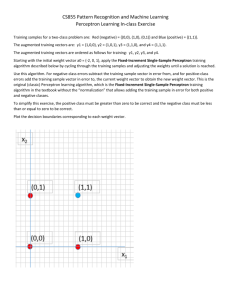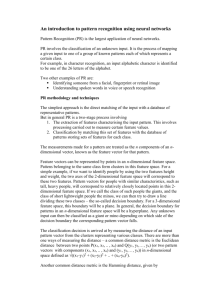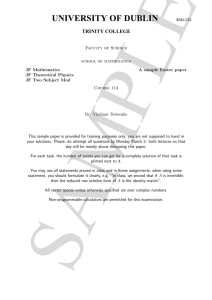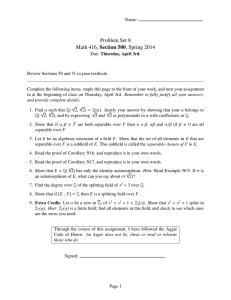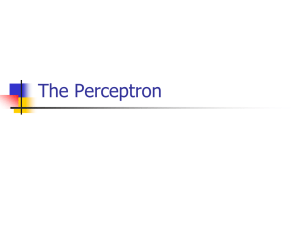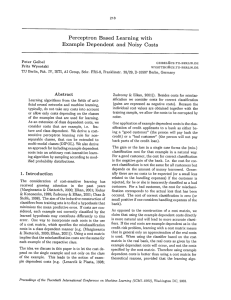x = (x , ..., x ) = vector of attributes (features)
advertisement
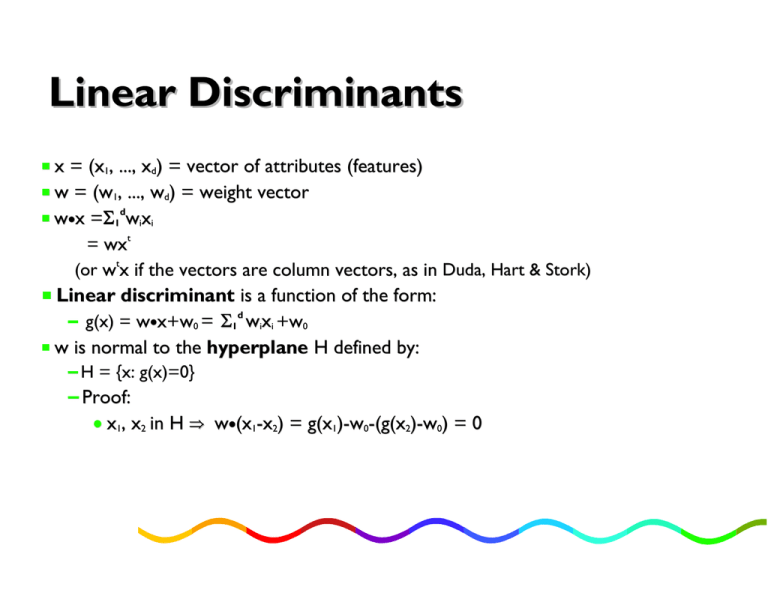
Linear Discriminants
x = (x1, ..., xd) = vector of attributes (features)
w = (w1, ..., wd) = weight vector
w*x =✟1dwixi
= wxt
(or wtx if the vectors are column vectors, as in Duda, Hart & Stork)
Linear discriminant is a function of the form:
g(x) = w*x+w0 = ✟1d wixi +w0
w is normal to the hyperplane H defined by:
H = {x: g(x)=0}
Proof:
x1, x2 in H e w*(x1-x2) = g(x1)-w0-(g(x2)-w0) = 0
Hyperplanes
g(x) = 1 g(x)= 0
ywy
y
g(x)= dy
g(x) = -1
x
d
Distance of H from origin
= |w0|/ywy
w
w0 is called "bias" (confusing!)
or "threshold weight"
Use g as a classifier: x is classified +1 if g(x)>0 i.e. ✟1d wixi > -w0
- 1 if g(x)<0 i.e. ✟1d wixi < -w0
Thus the classifier is Sign(g(x))
Extend from binary case (2 classes) to mulitiple classes later.
Threshold is an Extra Weight
w0 can be incorporated into w by setting x0=1
Then g(x) = w*
w*x = ✟0d wixi
Example:
d=1, "hyperplane" is just a point separating +ve from -ve points
Embed the points into d=2 space by making their first component 1
"hyperplane" passes through origin
x1
+
"hyperplane"
origin
+
"hyperplane"
x1
1
origin
x0
Perceptron
Input is x = (1, x1, ..., xd)
Weight vector = (w0, w1, ..., wd)
Output is g(x) = w*
w*x = ✟0d wixi
Classify using Sign(g(x))
g(x)
✟0dwixi
w0
x0=1
w1
x1
...
...
wd
xd
Linearly Separable
Given: Training Sample T = {(x1, y1), ..., (xn, yn)}, where:
each xi is a vector xi = (xi1, ..., xid)
each yi = !1
T is linearly separable if there is a hyperplane separating the +ve points from the
-ve points i.e. there exists w such that
g(xi) = w*xi > 0 if and only if yi = +1
i.e. yi(w*xi) > 0 for all i
-
+
-
+
lin sep
+
+
-
not lin sep
+
Finding a Weight Vector
Hypothesis Space = all weight vectors (with d+1 coordinates)
If w separates +ve from -ve points, so does ✍w for any ✍ >0.
How do we find a "good" weight vector w?
Could try "all" w until find one
e.g. try all integer-valued w in order of increasing length.
Better idea
repeatedly change w to correct the points it classifies incorrectly.
+
-
-
+
+
g(x) must be decreased
w
g(x) must be increased
Updating the Weights
If a +ve point xr is incorrectly classified i.e. w*xr < 0, then:
INCREASE w*xr by:
increasing wi if xri > 0
decreasing wi if xri < 0
If a -ve point xr is incorrectly classified i.e. w*xr > 0, then:
DECREASE w*xf by:
increasing wi if xri < 0
decreasing wi if xri > 0
For both +ve and -ve points, do:
w r w + yrxr if xr is incorrectly classified
NOTE: A point xr is classified correctly if and only if
yr(w*xr) > 0
Notational "trick" used by some texts:
multiply -ve points by -1
can express formulas more simply (without yi)
Perceptron Algorithm
Algorithm:
w=0
Repeat until all points xi are correctly classified
If xr is incorrectly classified, do w r w + yrxr
Output w
-
-
+
+
w
origin
+
1st component of w increases
2nd component of w decreases
Intuition behind Convergence
-
-
+
+
new w1
new w2
+
-
-
+
+
w
w*
+
new w is not guaranteed to
be closer to w* than w was,
but will be closer to some
multiple of w*
-
Perceptron Convergence Proof
Proposition: If the training set is linearly separable, the perceptron algorithm
converges to a solution vector in a finite number of steps.
Proof
Let w* be some solution vector i.e. yi(w**xi) > 0 for all i (Eqn 1)
w* exists because the sample is linearly separable
✍w* is a solution vector for any ✍ >0.
>0.
The update is:
w(k+1) = w(k) + yrxr if xr is misclassified
We want to show that:
|w(k+1)-✍
|w(k+1)-✍w*|2 [ |w(k)-✍
|w(k)-✍w*|2 -c for some constant c>0
We have:
|w(k+1)-✍
|w(k+1)-✍w*|2 = |w(k)-✍
|w(k)-✍w*+yrxr|2 = (w(k)-✍
(w(k)-✍w*+yrxr )*(w(k)-✍
(w(k)-✍w*+yrxr )
= |w(k)-✍
|w(k)-✍w*|2 +2(w(k)-✍
+2(w(k)-✍w*)*yrxr +|yrxr |2
Since w(k)*yrxr < 0 because xr was misclassified, we have:
|w(k+1)-✍
|w(k+1)-✍w*|2 [ |w(k)-✍
|w(k)-✍w*|2 -2✍
-2✍yr(w**xr )+|yrxr |2 (Eqn 2)
Convergence Proof (contd)
Since yr(w**xr) > 0 from (Eqn 1), our goal is:
pick ✍ so large that -2✍
-2✍yr(w**xr ) +|yrxr |2 < -c for some constant c>0
Let ✎ = maxi|yixi |= maxi|xi |
(Neither ✎ nor ✏ depend on k!)
✏ = mini yr(w**xr ) > 0
Then:
-2✍
-2✍yr(w**xr ) +|yrxr |2 < -2✍✏
-2✍✏ +✎2
Pick ✍ = ✎2/✏
Then:
-2✍
-2✍yr(w**xr ) +|yrxr |2 < -2✎
-2✎2 + ✎2 = -✎
-✎2
and so, from (Eqn 2)
|w(k+1)-✍
|w(k+1)-✍w*|2 [ |w(k)-✍
|w(k)-✍w*|2 -✎2
Since squared distances are never negative, this decrease must eventually stop;
i.e. the update rule "w(k+1) = w(k) + yrxr if xr is misclassified" stops changing w at that point w(k) = ✍w* for some ✍ and so w(k) separates the training points.
Same proof (different notation!) as in Duda, Hart & Stork, pg 230-232
Perceptron Algorithm (Details)
Implementing the algorithm in practice:
Need to cycle through examples multiple times
Update w after each cycle, not every example ("batch perceptron")
Learning Rate ✔
w r w + ✔yrxr
small ✔ gives slow convergence
large ✔ may cause overshoot
✔ can be updated each iteration, want ✔ = ✔(k)d0 as iteration kd∞
✔(k) = ✔(1)/k
Decrease ✔(k) if performance improves on kth step
Non Linearly-Separable
Perceptron Algorithm does not converge if training set is not linearly separable
Cannot learn X-OR or any non-linearly separable concept.
Pointed out by Minsky & Papert (1969) - set back research for many years
Linearly Separable training sample ^ underlying concept is linearly separable
As d, the number of dimensions, increases, random training set is increasingly likely to
be linearly separable
In practice, try get low error if not lin sep.
Heuristics:
Terminate when (length of) w stops fluctuating
Average recent w's
Choice of learning rate
-
+
-
+
X-OR
Gradient Descent
Suppose J is some function of the weight w which we want to minimize.
Gradient Descent searches iteratively for this minimum by moving from the
current choice of w in the direction of J's steepest descent:
descent:
w r w - ✔=J(w),
where =J is the vector (ØJ/Øw0, ØJ/Øw1, ..., ØJ/wd)
Terminate when |✔=J(w)| is sufficiently small
Example: J(w) = -✟M yi(w*xi)
where the sum is ONLY over the set M of xi misclassified by this hyperplane
yi(w*xi) < 0 if xi is misclassified, so J(w)>=0, we would like to minimize J.
Since yi(w*xi) = yi(w1xi1+ ... +wdxid),
ØJ/Ø
J/Øwr = -✟M yixir
=J = -✟M yixi
and gradient descent becomes:
w r w + ✔✟Myixi ("batch perceptron")
Thus Perceptron Algorithm does gradient descent search in weight space.
space.
Least-Mean-Squared
J(w) = Squared Error(w) = 0.5✟1n (yi -(w*xi))2
Since yi -(w*xi) = yi -(w1xi1+ ... +wdxid),
n
ØJ/Ø
J/Øwr = 0.5✟1 2(yi -(w*xi))(-xir)
n
=J = -✟1 (yi -(w*xi))xi
n
w r w + ✔✟1 (yi -(w*xi))xi
For faster convergence, consider the samples one-by-one:
w r w + ✔(yi -(w*xi))xi
the LMS (or Delta or Widrow-Hoff) learning rule.
same algorithm (different notation!) as Duda, Hart and Stork, pg 246.
basis of backpropagation algorithm for training neural networks.
LMS rule converges asymptotically to the weight vector yielding minimum squared
error whether or not the training sample is linearly separable.
However, minimizing the error does NOT necessarily minimize the number of
misclassified examples.
Multiple Classes
Suppose there are n classes c1, ...., cn
(1) 1 vs rest
Use 1 linear discriminant for each class ci, where points in ci are +ve, all points not in
ci are -ve.
Need n linear discriminants
Assign ambiguous elements to nearest class
(2) pairwise
Use 1 linear discriminant for each pair of classes
Need n(n-1)/2 linear discriminants
Assign points to class that gets most votes
Assign ambiguous elements to nearest class
(3) linear machine
Use gi(x) = wixt+wi0 for i=1 to n; Assign x to ci if gi(x)>gj(x) for all jg
jgi
Need n linear discriminants
No ambiguous elements
Multiple classes (1 vs rest)
+ not +
+
o
o
+
?
not -
-
+
o
+
-
-
-
Use n linear discriminants for n classes
Ambiguous region (?) - use distance to nearest class
not o o
Multiple class (pairwise)
- o
+ -
+o
+
+
o
o
?
+
o
+
-
-
Use n(n-1)/2 linear discriminants for n classes
Ambiguous region (?) - use distance to nearest class
-
Linear Machine
Define n linear discriminants:
gi(x) = wixt+wi0 i=1 to n
Note typo in Duda Hart and Stork, pg 218! (gi(x) = wtxi+wi0)
Assign x to class with largest value:
x belongs to ci if gi(x) > gj(x) for all jg
jgi
Divides space into n regions, where each gi is largest
Regions are convex and single connected
No ambiguous region
The boundary between any 2 contiguous regions is a hyperplane:
Hij = {x: gi(x) = gj(x)} = {x: (wi-wj)xt +wi0-wj0 =0}
Thus differences between weight vectors are normal to the boundaries
May not have all n(n-1)/2 boundaries
How does the definition of linearly separable generalize to multiple classes? (See
Homework)
Multiple classes (Linear machine)
H+o
+
+
H+-
o
o
+
o
+
-
-
Use n linear discriminants for n classes
No ambiguous region
-
H-o


